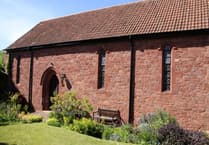ON February 24, members of Thorverton History Society had the pleasure of a very well attended and popular talk from our local author, transport specialist and vintage film collector, Amyas Crump on the familiar and well loved Exe Valley Railway.
Sadly, axed in the infamous 1960s Beeching Cuts, the line and its association with village life is still remembered by many in Thorverton and the facts, anecdotes and photographs presented were thoroughly enjoyed by the audience.
Amyas illustrated his introduction to the extent of the connectivity with a 1900 map of the local network.
The Exe Valley Railway was a branch line built by the Great Western Railway (GWR) and was in constant use from 1884 until the line was sadly closed to passengers on October 7, 1963.
It ran for almost 25 miles through beautiful Devon countryside and Tiverton was of early significance in the early railway network. It remains a happy memory for those who were lucky enough to travel along this picturesque route.
Although the line has been dismantled, most of the route remains unbuilt on, a tantalising thought… and is familiar still for the many recognisable railway buildings, many of which are now private homes, and infrastructure still evident in the local landscape.
For railway enthusiasts the last actual steam engine, a familiar sight pushing the freight and passenger coaches up and down the line rests in Tiverton Museum, the gift of Viscount Amory.
Affectionately known as the "Tivvy Bumper”, it was one of the GWR designed 1400 Class steam trains that was intended for branch line work.
The 1400 engines were designed to work with a specialist coach convenient for push-pull working (meaning that the engines didn’t need to be turned around before making a return trip up the line). These were ideal for working on branch lines, and were used on both the Exe Valley and Culm Valley lines.
Originally introduced in 1932 as the 4800 Class, it was renumbered in 1946. There are four examples of the 1400 Class that have been preserved. The Tiverton 1442 of course, 1420 at Buckfastleigh on the South Devon Railway, 1450 on the Severn Valley Railway in Shropshire and 1466 awaiting an overhaul at the Didcot Railway Centre in Oxfordshire.
We all enjoyed a measured progress up the line from Exeter to Tiverton and beyond, accompanied by anecdotes and detailed and personal knowledge supplied by Amyas, visiting all the various stations with images of the past.
Thorverton was indeed one of the busiest stations along the route to Tiverton.
In the 1920s Margaret Chubb recalled: “Friday was, as now, market day in Exeter. Farmers from the surrounding countryside arrived at the Dolphin early in the morning with their lovely big horses and laden carts.
"Several horses were left for the day, some in the stables or loose-boxes and others just tied up in the yard. The families then walked down Silver Street to the station to join the train to Exeter.
"The wives would be carrying large baskets, covered with spotless white cloths under which were dressed chickens, eggs, butter, cream and cheese to sell in the Pannier Market in Exeter's Queen Street.”
In June 1961, the then Duke of Edinburgh piloted his own helicopter into Thorverton to visit the Devon Education Committee’s Youth service camp.
He then slept on a special train parked in the sidings at the station. He spent the night there with a cordon of police officers on guard outside, and the early trains next day were cancelled lest they should disturb his sleep.
Special buses were put on to take people to work and school in Exeter and Tiverton. Questions were later asked in Parliament about these happenings!
Finally at Tiverton, Amyas identified where the impressive and extensive site of Tiverton Station could be found. Opened in 1848, if you should go to Weston-super-Mare, you will find the same building design.
It extended to five different coal yards, sidings and enormous sheds. Indeed the feature of the Great Western Canal survived as a water supply for the railway long after the decline of the inland waterway for freight.
This was a fascinating journey into local and recent history which rekindled many memories.
Recorded by Ann Marshall





Comments
This article has no comments yet. Be the first to leave a comment.